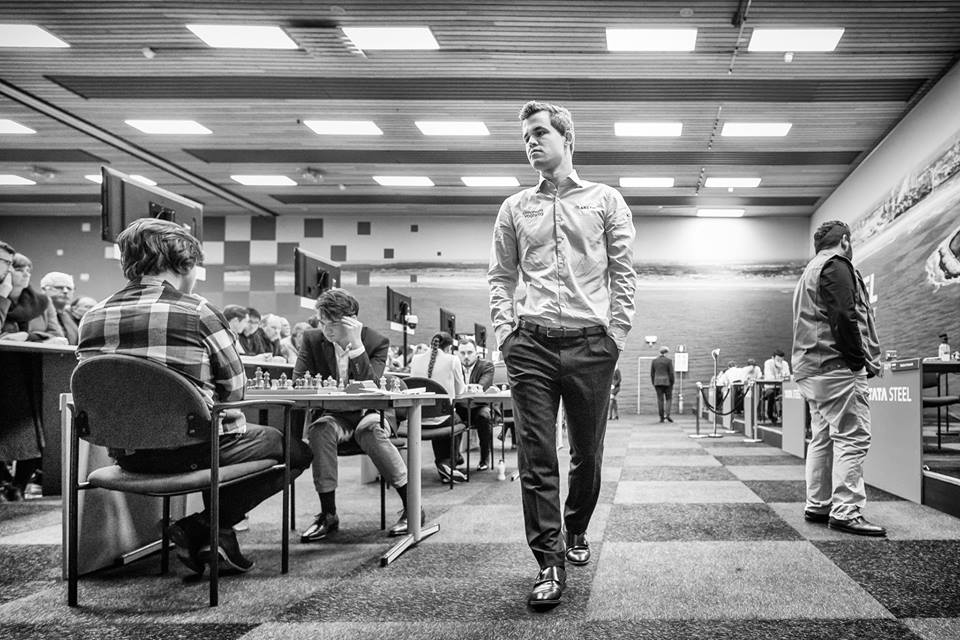


Wijk aan Zee received a large mix of well-established, promising and veteran players at the 81st edition of the traditional Dutch event. An even larger group of amateurs filled the playing hall and recreated the atmosphere that customarily opens the chess season every year. Most of the eyes were, naturally, on the Masters tournament, and the protagonists did not let their fans down — fighting struggles were seen on all boards.
At the very outset of the event, we saw the first surprise, as six-time defending champion Magnus Carlsen was faced with a novelty on move five, courtesy of Ding Liren. The Norwegian confessed that for him the surprise arrived even earlier, given the fact that he did not expect Ding to play 1.Nf3, 2.g3. Soon enough, he gave up an exchange for compensation but, as he mentioned in the post-game interview, in the subsequent fight he "was the one that was always kind of fighting for my life".
It is not a simple task to defeat the World Champion, though, and Magnus pretty much closed the deal by going into an attractive forcing line that led to a draw:
Magnus took two minutes to decide on 27...Rxf3 and after 28.Nxf3 e4 29.Qe3 Nxf3+ 30.Rxf3 Qxf3 31.Qxf3 exf3 32.Kf2 the players signed a draw in a completely equal opposite-coloured bishop position. (You can move the pieces yourself on the diagram above!)

The six-time champion strolling in the playing hall | Photo: Alina l'Ami
The Norwegian defending champion tied in points last year with local hero Anish Giri, but the Dutchman had a rough start in this edition, as he lost in only 26 moves against Ian Nepomniachtchi's Pirc Defence. Giri was already in trouble with the white pieces, but when he gave up a piece there was not much more to play for:
Anish could only play the ugly 18.Nb1 to maintain some hopes, but instead gave up the knight with 18.exf5? and resigned the game only eight moves later. Nepomniachtchi talked about his opponent's decision later on:
Anish Giri would be happy to repeat his triumph from last year and to become the next legend of the Dutch chess, while Nepo was returning to Wijk aan Zee after a hiatus of one year. The score between them was equal though the last win was registered by Anish in the 2017 edition. And with Nepo you can always be sure that the game will always be entertaining!
The other winner of the round was five-time Wijk aan Zee champion Vishy Anand, who showed lowest-rated Jorden van Foreest how hard it will be for him to face such a strong field by beating him in 28 moves with Black from a Caro-Kann Defence. When Fiona Steil-Antoni talked to Vishy afterwards, she pointed out that players have been getting good positions with Black lately — referring to the fact that he and Nepo had won with the black pieces. A level-headed Vishy answered pragmatically:
There are only two colours in chess, and there will be a trend this way and there will be a trend that way. I think this is essentially meaningless, these trends.

A smiling Vishy after a good start | Photo: Alina l'Ami
While Anand started off on the right foot, his old-time friend and rival Vladimir Kramnik was suffering against Teimour Radjabov. The Azeri got a space advantage on the queenside and put pressure on Big Vlad until the Russian found himself in a clearly worse position. Kramnik kept on fighting, though, and his efforts paid off on the last move before the time control:
A quiet move like 40.Rc1 or 40.Rb1 would have kept White's advantage, while after 40.Rxa4? Black got an active queen and managed to create a triple repetition. Draw.

Radjabov was very close to victory | Photo: Alina l'Ami
The rest of the games were more balanced, but debutants Fedoseev, Duda and Shankland were the ones pushing in their games against Rapport, Vidit and Mamedyarov.
IM Merijn van Delft analyses the games from the venue itself
Three out of four winners in the first round of the Tata Steel Challengers obtained victories with the black pieces — it should just be a coincidence, according to Vishy!
In the four-player leading pack, we find Evgeny Bareev who, at 52, defeated the youngest participant of the event, 13-year-old Indian prodigy Praggnanandhaa. The Russian-born veteran now represents Canada, and he actually won the event sixteen years ago, before Pragg was even born!

The youngest against the oldest in the Challengers | Photo: Alina l'Ami
Anton Korobov is almost twenty years younger than Bareev but can also be considered a veteran next to the current Junior World Champion Parham Maghsoodloo. The ambitious Iranian youngster allowed Anton to give mate on the board:
38...Qxh2#.
Besides Bareev and Korobov, Dutchman Erwin l'Ami and Russian 22-year-old Maksim Chigaev started with wins on the first day.

Korobov tends to start well in Wijk aan Zee | Photo: Alina l'Ami